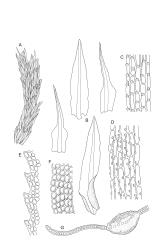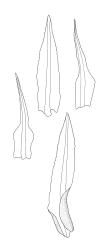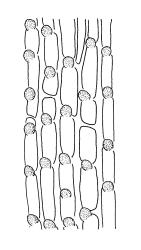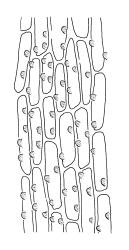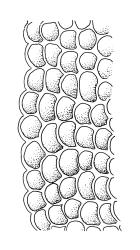Plants yellow-brown, forming turves. Stems unbranched, to c. 30 mm, sparsely beset with very coarsely papillose brown rhizoids. Leaves usually longer and slightly more crowded near stem apices, 3.5–7.0 × c. 0.8 mm, moderately crisped when dry, erect-spreading when moist, broadly lanceolate, acute, coarsely and bluntly serrate in upper portion of limb, with a moderately defined upper limb and a lower sheath that occupies 1/8 to c. 1/4 the leaf and is pale in upper leaves but dark red-brown in lower leaves; upper laminal cells (mid limb) rounded-quadrate, 9–15 × 7–9 µm, strongly mammillose adaxially, plane abaxially; cells of the sheath c. 60–100 × 12 µm, weakly porose, smooth adaxially, abaxially with 2–5 large (c. 6–10 µm diam.), round, and verrucose papillae over lumens, narrower and not or less distinctly papillose at margins, gradually merging with cells of the limb; cells at base of sheath fragile and hyaline in a single band; costa of limb adaxially covered with short-rectangular cells that are mammillose (prorate) at upper ends, abaxially covered with longer (c. 15–30 µm), weakly-projecting or non-projecting cells, teeth at apex absent or obscure, in cross-section with adaxial cells strongly mammillose, a single row of guide cells, and two large stereid bands; costa of sheath adaxially covered with long rectangular (40–54 × 9–15 µm), smooth cells, abaxially with long rectangular, weakly mammillose cells, in cross-section with adaxial cells plane, abaxially cells weakly bulging, a single row of guide cells, a small adaxial and a large abaxial stereid band.
Dioicous. Neither male nor female gametangia observed in N.Z. material.
Smith 2004, fig. 161, 5–8.
SI: Nelson (Mt Arthur Range, Mt Owen Range).
Bipolar. Widespread at higher latitudes in the northern hemisphere and extending southward as far as the island of Newfoundland and to montane sites in Colorado (Brassard 1979).
On humus and marble/limestone rubble in the calcareous mountains of Nelson L.D., where it ranges from 1200 to at least 1650 m elevation (but recorded from "c. 1800 m" by Horton & Bartlett (1983)). Associated mosses include Bartramia papillata, Amblystegium varium, and Distichium capillaceum. Horton & Bartlett (1983) cited Encalypta rhaptocarpa, Tortella fragilis, Isopterygium pulchellum and Bryoerythrophyllum recurvirostrum as associates.
Brassard (1984) uses primarily the width of the laminal limb cells and presence of papillae on the abaxial (dorsal) surface of the limb costa to distinguish between the var. norvegica and the var. excurrens. The laminal limb cells in N.Z. material are generally 7–9 µm wide (thus according with the dimensions given by Brassard for var. excurrens). The abaxial surface of the limb costa has cells smooth or nearly so in the middle and only weakly projecting at the side of the costa. There are no teeth clearly visible near the abaxial apex. N.Z. material is thus difficult to assign confidently to either of the two varieties recognised by Brassard (1984) using his key, as noted by Horton & Bartlett (1983). The distinction between the two varieties is of little significance in a N.Z. context as it is clear that our material is referable to T. norvegica s.l.




